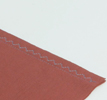How to Sew a Single-Fold, Clean-Finish Seam | Video
Staystitching and edgestitching are part of this technique
Threads author Sandra Miller shares her simple techniques for sewing common seam finishes in Threads #165 (Feb./March 2013) and in #166 (April/May 2013). In this quick video tutorial, we bring one of her techniques to life and demonstrate how to sew a single-fold clean finish seam. This method works well with lightweight fabrics that do not fray much. Try this method to achieve great looking and durable seam allowances. Get other helpful techniques like this with a subscription to Threads magazine, which comes with FREE access to our tablet editions.
Don’t miss Sandra’s techniques for sewing other common seam finishes. Sandra is a sewing teacher, pattern designer and tester for Cutting Line Designs, and she has authored many articles for Threads.
 How to Stitch Together Seam Allowances
How to Stitch Together Seam Allowances
This finish is useful when working with knits to keep edges flat and crisp. Try this method to achieve great-looking and durable seam allowances.
How to Sew a French Seam Finish
French seams work best on sheer, lightweight fabrics. The narrower you make them, the more professional they look. Learn how to sew a French seam with this quick video tutorial.
A serger trims and overlocks the seam allowances separately or together as it stitches.
For more in-depth sewing tutorials hosted by Sandra, see these Taunton Press products:
Sewing Essentials: The Perfect Blouse











































In the video, the narrator presses the seam open and presses the finished seam allowances without placing anything between it and the garment, resulting in an ridge. I was taught never to press over the edge of a seam allowance or the top of a hem without placing a manila strip, envelope or whatever between.
I agree with user-248711. This to me is a no-no.
Why go to all that trouble when you can serge or zig zag. Even serging can cause problems if the fabric is light.
This video makes a really simple clean finish much more complicated than it really is. DON'T DO IT! THERE'S AN EASIER WAY!
All you have to for a clean finish is:
1. Before sewing the seam, press each layer of fabric 1/4" towards the wrong side (by folding over as you sew,finger pressing or iron if you need to)and edgestitch.
2. Then, sew your seam normally to join the layers (with the 1/4" taken out of the allowance. So, if it's a 5/8" seam allowance, sew 3/8").
3. Press the seam. You're done!
You can use clean-finish for any fabric. For heavyweight fabric it will add bulk to the seam, so you probably don't want to use it in that case. It's one of the old methods used before serging was used, so it's naturally bulkier than serging and more time-consuming.
I like it. I would use this when I want a cleaner look than ready to wear.
I would also sew the seams first, then do the finish. I think the sewn seam allowance will be more accurate that way. Then I don't need to think about being completely accurate when folding the edge under.
I like the focused video that only shows one technique.
I used this method before I bought my serger. I also find it more accurate to sew the seam first. I don't bother with stitching a line at 1/4". I just fold under and edge stitch.
When the experts write a sequence of steps, I listen. Wow. This is sure wonderful to know. Sometimes, these little lessons are just right to show a child just learning to sew due to the fact that they do not tackle serging till much later on. If I take my machine along on a holiday, I am not going to pack my serger, too. So, to know a set of steps like this is invaluable. I always want my sewing to look neat.
Thanks for this tutorial!
I use my serger on almost everything, but I do like the idea of the clean finish on unlined jackets! I think it gives a couture look, which is much better than a serged finish! Someone will see the inside of that unlined jacket!
Beautiful FINISHED seam...personally I think serging gives a cheap looking finish.
Nicely done video, clear and to rhe point!!
If you are going to stay stitch the edges at a 1/4", I would do it prior to stitching the seam. This makes for less handling of light fray prone edges, and it is also done flat as opposed to after the seam is sewn, which can be fussy.
Hi everyone! I'm Sarah, the editor who demonstrated for the videos. I wanted to thank everyone for their feedback. We appreciate that there is more than one way to sew this type of seam finish. We sewed the seam first, but you can use a different sequence to achieve the results. The advice about using a manila strip or other means to buffer the allowance during pressing is excellent, thank you for reminding everyone of this prudent step. There are many types of seam finishes, and in the coming weeks, you'll see more presented here.
I generally make french seams or flat felled seams, and occassionally pink them. That being said. These look like they would lay really nice. Thanks.
PS I HATE serging, makes the garment look cheap to me.
Excellent tip, and an easy vid to boot. It's also nice when readers add useful comments, as it makes you think about the pros and cons of different approaches. My take on the sequence of events is that an initial fold might be faster, but an edge folded over a line of stitching would be more accurate, more stable and generally more polished. So when the choice is to be made, I would consider the type of item, what it was made of an how it will be used.
As for sergers, I don't own one, so that point is moot. I realize they're popular, but it's a cost priority thing, and call me old school, but I'm really not keen on the look of it, either. If I had the $$ to buy another machine, it would likely be an embroidery one. I dream of adding finishing touches with simple, same colour embroidery. For example one could add a small, tasteful border or a corner motif to the cuff edges (and/or collar) of a simple crisp shirt. Initials or images inside linings would be great, too. Perhaps a small geometric near the beginning of a featured godet?
Ooops, off topic. (laughs) But you see how it could be a no-brainer choice?
Video is constantly unavailable.
Luv, luv, LUV THIS!!!!!
Sandra, I for one am looking forward to more of these video tutorials.
Victoria and Evamarie did an outstanding job producing such a clear and clutter-free video.
Threads imparts, and we improve.
Thanks!
Beautiful Looking Seam!!!! I will definately use this method!! Thank You!
I would LOVE to be able to download ALL Threads instructional videos!!! PLEASE????????????
New to 'Threads' and loving it.
Recently undertaking a rather large project with a vintage pattern and I have some very expensive Italian wool I am using.
Can anyone recommend the best way to finish the seam for a professional look without adding bulk. Should I pink them????
Thanks for the videos, sometimes seeing along with reading the directions makes things a lot easier to understand. Keep those videos coming!!!
It doesn't show what they look like on the other side.
As a quilter, my advice is to use a 1/4" foot to achieve the most accurate stitch line.
I love the finished look, but this requires five passes over the same seam. I would use it only occasionally, in places where nothing else will do and the seam will be visible.
I agree with others: the videos are marvelous. 35 seconds is just right to show a technique. Then I can get right back to sewing. Thank you, Threads!
Love it! Thank you so much. Yes love these short videos. This one will be useful for garments.